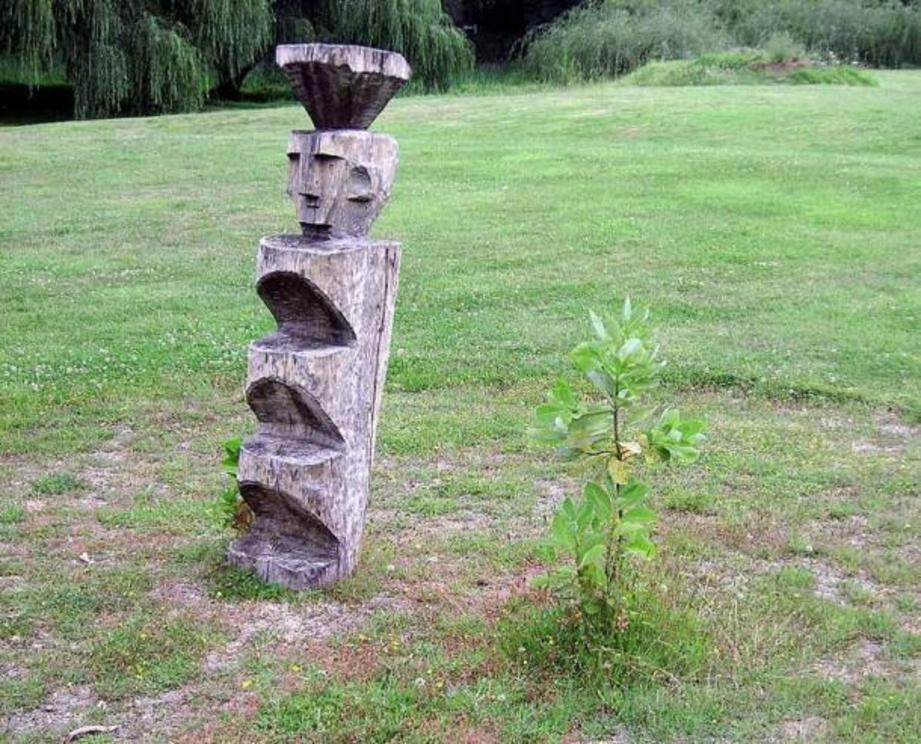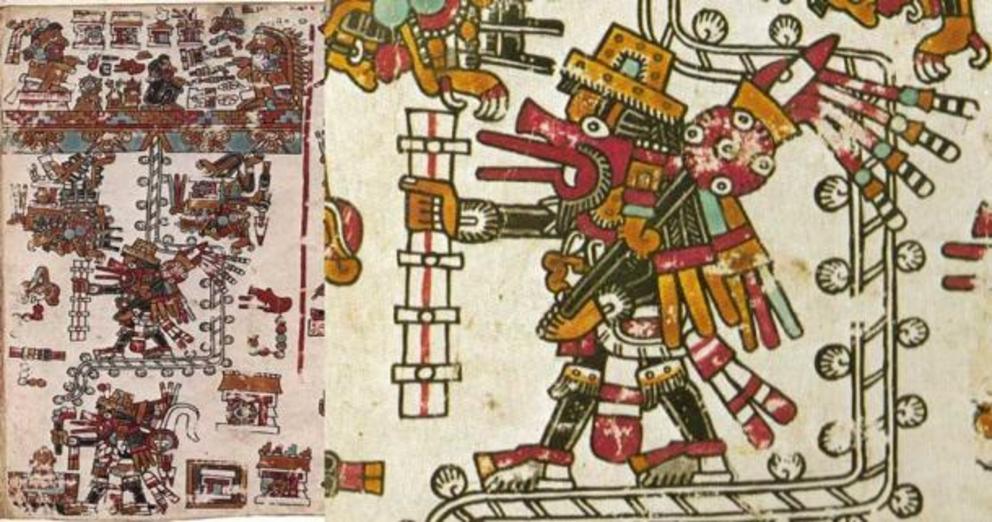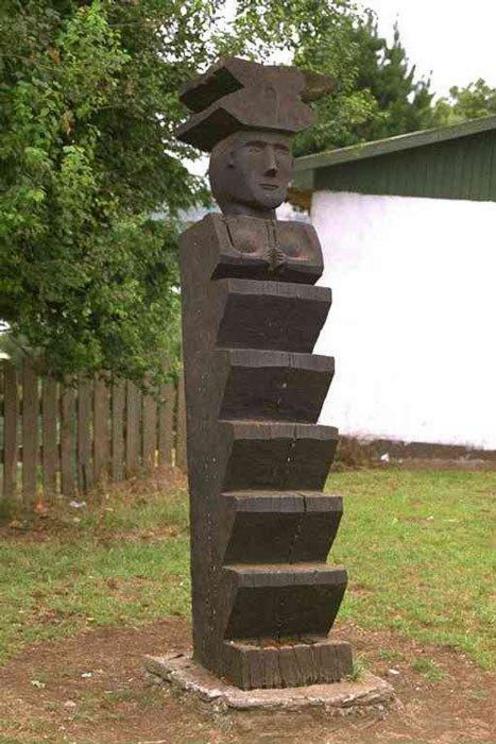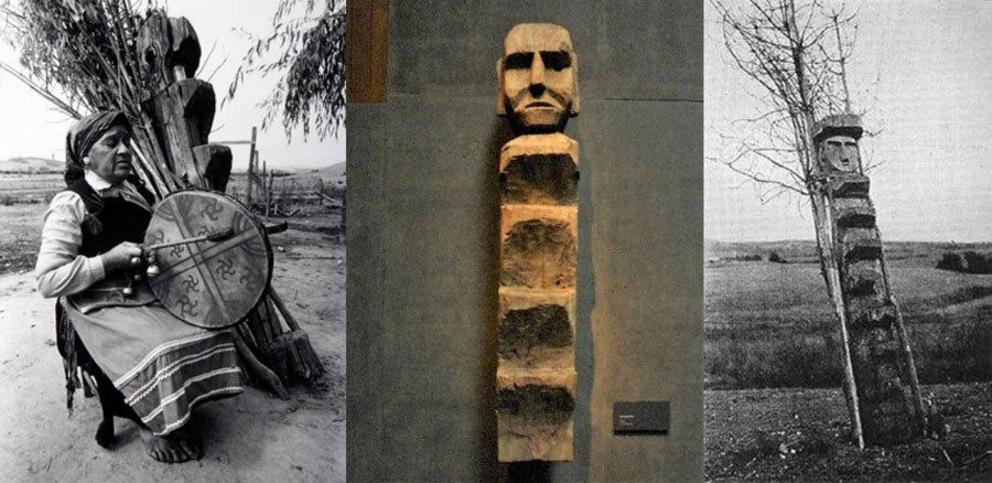Araucanian ‘staircase to heaven’ symbolism in the pre-Hispanic world
Top image: Left: Machi playing the Kultrún. Behind her it can be seen the inclination of the staggered Rehue . Center: A Rehue in the exhibition of the Museo Chileno de Arte Precolombino. Right: A Rehue as a symbolic figuration of the Tree-Man.
One of the fundamental magical-religious symbols of the Lituche-Araucanian (also known as the Mapuche culture) cultural substrate of Chile is the Rehue or stepped totem carved in wood.
The Rehue is a representation of the Axis Mundi , the Invisible Column of the World or The Cosmic-Polar Tree. In its upper part, it has an anthropomorphic face evoking the ANTHROPOS or Cosmic Man from Western tradition. Is it the Fucha-Huentru-Nguenechén, literally, the “Old-Man-God” of the Araucanians?
Sometimes the anthropomorphic figure of the Rehues features a Callana or “plate” that protected the head of the Lituches from the Sun.
The Lituches were the survivors of the Flood or Tripalafken.
The “steps” of the Rehue, usually seven, allow the real and symbolic ascent where the ancient Machis and initiates sought to contact the Wenu Mapu , that is, the “Land of Heaven” where the Antupainko, the “Children of the Sun” ancestors dwell.
Significantly, in the Nguillatún or Pillantún a rogative or prayer or supplication is made to the Supreme God, the Chao Ngnechén . The Rehue is located in the center of the sacred space or Nguillatuhue. Thus, guided by the Machi or the Ngillatufe, the participants took part in a ritual dance in an anticlockwise direction around the Rehue to the sounds of the Kultrún, the sacred drum, until its culmination with the vocalization Aum! Aum! Aum!
 A Rehue of the Araucanian culture and a sacred canelo tree on the grounds of the Austral University of Chile.
A Rehue of the Araucanian culture and a sacred canelo tree on the grounds of the Austral University of Chile.
The Araucanians’ Way of Uniting Earth, Heaven and the Stars
This rite, like the space where it takes place and the symbol of the Rehue are a magical-religious Araucanian evocation of the means that united the Earth, the Chili Mapu , to the plane of the Pillanes god, and the inhabitants of the stars, the Wenu Mapu .
There is, along with these components, an intangible element that is the inclination angle presented by the Rehues. They have an obtuse angle of approximately 105 to 110 degrees, forming the vertex and the anthropomorphic front of the Rehue. But why this particular feature? What was its origin and function?
This inclination would be an evocation of the old terrestrial axis, that is, a symbol of the polar axis prior to its change as a consequence for the Great Catastrophe or Tripalafken. For this purpose, a Mapuche informant, the Mapuches are the heirs of the Araucanian tradition, stated that the Mapuche ‘lives since the beginning of the world; we are antediluvians. Chao Ngenechen created us and gave us the land we live in .’ (Forester, 1993)
The key to understanding is the epithet of “ antediluvians.” Their descendants preserved through their symbols and myths the fragments of a remote worldview. The Rehue is then both a symbol of the Axis Mundi and a figuration of the “Staircase to Heaven” leading to the Wenu Mapu.
 The Catíos-Chocoes people of Antioquia in Colombia refer to a “Staircase to Heaven,” which is what the Rehue is.
The Catíos-Chocoes people of Antioquia in Colombia refer to a “Staircase to Heaven,” which is what the Rehue is.
Like the Araucanians, the Colombian Catíos Had A Staircase
A myth of the Catíos-Chocoes of Antioquia in Colombia also refers to this “Staircase to Heaven.” This quote from the Mitos y leyendas de Colombia (Myths and legends of Colombia) states:
“The god Caragabí had a marvelous staircase, very different from those manufactured by the Indians, which came from earth to heaven so that the Catíos could come up to talk with him whenever they wanted. This strange staircase was like a very thin glass and had the flanks defended by railings and rails made of a much burnished metal, in order to avoid the vertigo to those who went up or down and it rested on the ground on two strange and beautiful flowers.” (Villa Posse, 1993)
When the first Indians sinned Caragabi took the staircase from them so they would not go back to heaven . As punishment, he also passed his creative hand through the eyes of the Indians, as if rubbing them and took away that prodigious visual power that they initially possessed. He then spilled coconut water on their heads to age them.
The “sin” that caused men such severe punishment was fornication. Some Indians added certain circumstances about the fall of the first men clarifying that a sinful woman when trying to climb the stairs of heaven to speak with Caragabí, next to her son, fruit of sin, which when touching with her hands one of the two mysterious flowers on which the staircase rested, caused at that moment the collapse of the great staircase: Those who were already climbing the top of it, managed to enter the sky; everyone else fell to the ground .
Was the staircase just a metaphor or an object? The Gyelrap, a genealogical text of the ancient Tibetan rulers accounts twenty-seven kings, seven of whom descended from the firmament to Earth on a staircase.
The same idea was recorded by Karl Maria Wiligut in the Fifth Human Era of the Description of the Evolution of Humanity According to the Secret Tradition of Our Asa-Uana Clan of Uiligotis (1935) based on a remote Germanic source.
Furthermore, the Catíos of Colombia also say that the primitive Indians from the Earth heard very well the songs and music coming from heaven because at that time it was not as distant as it is now.
But men were delighted by such wonders and agreed to build a staircase that would reach the sky. However, Caragabí opposed this action, but the Indians persisted in their attempt and when they reached very high Caragabí outraged by their disobedience knocked them down from above and took the pavilions of the sky much further, so that men would not try to build another staircase .
Another myth of the Catíos speaks of Herupotoarra, a descendant of the lineage of the Domicoes and who was the architect sought by Caragabí himself to build the staircase to heaven for the exclusive use of men.
The name of Herupotoarra means “Born of the Leg” because he emerged from the calf of his mother, who died at the time of his birth. When Herupotoarra came of age he found out who had been responsible for the cause of his mother’s death. It was assured to him then that the responsible entity was the Moon and for that reason Herupotoarra placed two sticks in the form of stairs and decided to avenge his mother. And to the extent that Herupotoarra said: Uariade, uariade (“Go up”, “go up”) and the staircase extended vertically until it reached the presence of the Moon, which he rebuked and without giving it time to replicate he discharged in its face such a tremendous strike that the marks can still be seen in the Moon.
A Trienené or woodpecker that was flying nearby landed next to the staircase, shutting it down and making it fall.
Herupotoarra, attached to the staircase said while he was falling: Mojopodo, mojopodo (“Without weight, without weight”). And so, he went to gently fall to another planet under Earth called Armucurá. There Herupotoarra learned that the inhabitants of this planet were immortal; they fed on steam that gave off cooked Chontaduros and were free of natural needs.
Later, Herupotoarra built the staircase again and climbed into this world.
Is it only about myths and fantasies of the pre-Hispanic inhabitants of Colombia ? Where and how did the idea of beings living in heaven come about? How can it be explained the conception of a “staircase to heaven” in primitive societies without technological development that would allow them to conceive the existence of extraterrestrial beings and of other inhabited worlds?
The same notion of the “staircase to heaven” is observed in the Codex Vindobonensis with the image of the god Ehecoatl-Quetzalcóatl descending a “ladder” from a celestial platform. This is the path suspended in the sky called Kuxa’an Suum , the “Living Rope” of the Mesoamerican tradition.
Is the celestial platform from which Ehecoatl-Quetzalcóatl descends a cosmic vehicle? Is this idea not similar to the “pavilions” of Caragabí?
 Ehecoatl-Quetzalcóatl descending a ladder from a celestial platform from the Codex Vindobonensis, with a closeup of the ladder on the right.
Ehecoatl-Quetzalcóatl descending a ladder from a celestial platform from the Codex Vindobonensis, with a closeup of the ladder on the right.
The People of the Stars Shared The Views of the Araucanians
A pre-Columbian myth of the Makiritare of Venezuela is even more specific because it refers to a struggle between men and the People of the Stars and their return to the sky:
The People of the Stars listened to the Jaguar and killed and ate a woman.
Kuamachi wanted to punish them, but they were too many and too powerful. Kuamachi went then where Wlaha, his chief, and invited them to help in the collection of Dewaka fruit. They became suspicious but Kuamachi offered them some fruit and as they liked the taste they decided to help in the collection.
Then Kuamachi and his grandfather Mahanama took them to the trees. The People of the Stars climbed the trees and began to eat the fruit, since they were no longer afraid of only these two people. Kuamachi dropped a fruit and in that place came water that spread and caused a great flood that covered everything except the trees.
Kuamachi then thought “canoe” and a canoe appeared. He and Mahanama got on the canoe. Mahanama threw the baskets he was weaving into the water that turned into anacondas, crocodiles, alligators and other deadly animals. Then Kuamachi set fire to a termite nest filling the forest with smoke. He and his grandfather picked up the bows and arrows they had hidden in a cave.
When they returned and the smoke had dissipated, the People of the Stars implored mercy. Both threw arrows at them.
The People of the Stars fell into the waters and were attacked by dangerous animals. Then, before throwing arrows at Wlaha, the leader of the People of the Stars, Kuamachi and his grandfather were left without arrows. He had transformed into seven people and had collected seven arrows.
The People of the Stars who were injured went back up to the trees. Wlaha shot the arrows to the sky and with the help of Ahishama, which became the turpial, and Kütto, which became a frog, built a staircase with which he and the Star People who survived, went up to the sky and became stars.
Ahishama became Mars; Wlaha became the Pleiades, Mönettä, the scorpion, became the Ursa Major, and Ihette, ‘One Leg’, became the Orion Belt. Kuamachi also decided to ascend. He had Kahshe, the piranha, with whom he cut the vine behind him so that the demon Ioroko could not come up with his basket of poison.
Kuamachi brought Akuaniye, the Plant of Peace with him, the one he offered to Wlaha, and then they stopped fighting.
Then Kuamachi became the Evening Star. Before this, the sky was empty and black . (From De Civrieux, M. Watunna: An Orinoco Creation Cycle)
“They built a staircase with which he [Wlaha] and the People of the Stars who survived, went up to heaven and became stars”!
Along with the essential reference to extraterrestrials in this pre-Hispanic record there is an echo of the Deluge and the ascension of the People of the Stars to the sky. As elucidated by anthropologist Adela Fernández according to the Mesoamerican myth after the Flood the gods, to repair such a catastrophe, in the year 1 Tochtli, after the Flood, they created four men [Atemoc, Itzacoatl, Itzmaliya and Tenoch]. Penetrating below the ground they made four holes, until they reached the upper surface; Tezcatlipoca became the Tezcacuahitl tree [Mirror Tree] , Quetzalcóatl the Quetzalhuexoch tree [Beautiful Willow] , and men, trees and gods raised the heavens, holding them firm with the stars in the way they are now. In recompense of that action, the Tonacatecuhtli [the “Lord of Our Flesh”, the First Divinity] made his sons the lords of heavens and stars, and the heavenly path that Quetzalcóatl and Tezcatlipoca traveled is marked by the Milky Way. (from Dioses prehispánicos de México , by Fernández, A. )
Since that distant past where history has merged with the Golden Mists of myth –the Great Flood – it is expected the return of the god-men, of those beings that live in the stars.
 In the enclosure destined for the nguillatún the Araucanians planted a large branch of canelo, the sacred tree of the Mapuches, and another of maqui, tied to the Rehue ladder trunk (pictured here), and at its foot they placed lambs, bread and chicha made
In the enclosure destined for the nguillatún the Araucanians planted a large branch of canelo, the sacred tree of the Mapuches, and another of maqui, tied to the Rehue ladder trunk (pictured here), and at its foot they placed lambs, bread and chicha made
The Future in the Past
The Rehue of the Araucanians, the ancestral accounts about Caragabí and Herupotoarra of the Catíos-Chocoes, the myth of the People of the Stars of the Makiritare, and the Kuxa’an Suum of Mesoamerica present a clear notion of the “staircase” as a means of union between two planes: the terrestrial and the heavenly. Between the world of men and the world of the gods.
What is the explanation of the recurrence of this “staircase” in the pre-Hispanic world of the Americas? Would it obey a function of the primitive psyche? If so, with what meaning and purpose? Could its presence be explained due to the fertile pre-Hispanic imagination as the evolutionary historiography exhibitors would argue? Or rather, is it possible to observe in this symbol an anticipation of a future technology, a “memory of the future?”
Today we understand that these magical-religious figurations of the “staircase” are in fact evocations of an unknown technology of the time before history and whose function –the union between planes– was perpetuated by means of rituality and the memory of the extraterrestrial gods .

